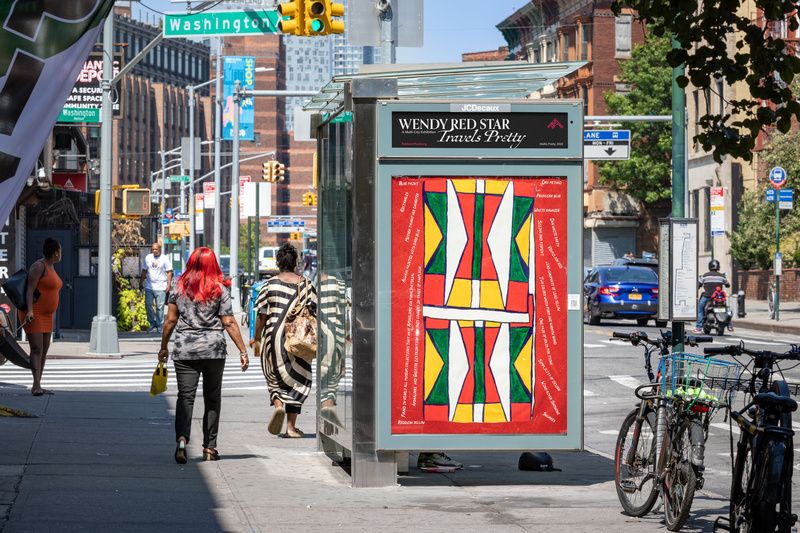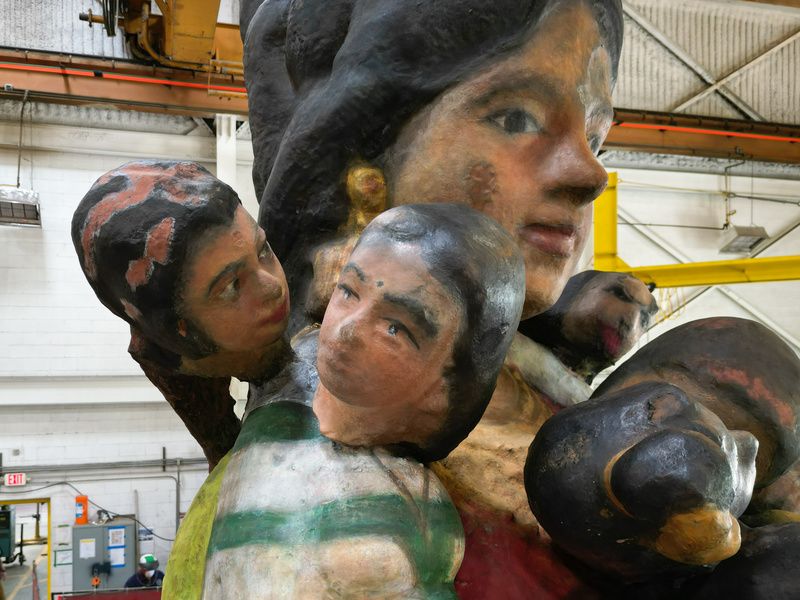Last Chance to Catch NYC's Holiday Notalgia Train
We met the voices of the NYC subway on our nostalgia ride this weekend!



With summer’s end just around the corner, be sure to enjoy some of New York City’s best public art installations this September while the weather remains ideal for walking outside. Much of the artwork on display this month draws from the rich cultural diversity of New York City. Viewers of Wendy Red Star’s painting series Travels Pretty can learn more about the history of Native American women while Somos Uno provides insight into the disparate cultures that make up the District 25 community. Head to Montefiore Square to marvel at a public mural representing the essence of the Hamilton Heights community or Times Square to view Midnight Moments‘ new film on the connections between bodies of water and living beings.

Located across 300 JCDecaux bus shelters in New York City, Chicago, and Boston is artist Wendy Red Star’s 12-piece acrylic painting series, Travels Pretty. Drawing from her upbringing on the Apsáalooke (Crow) reservation in Montana, Red Star seeks to shed light on the complex and often misunderstood histories of Native Americans through a feminist Indigenous lens. To do so, she reinterprets the patterns and colors of parfleches, vibrantly painted rawhide bags made by female members of nomadic tribes in the North American Great Plains, in the designs of Travels Pretty. As a means of celebrating the women who crafted parfleches and were never credited for their craftsmanship, all twelve of the paintings are named after women from the 1885 Crow Census.
Traditionally, parfleches served as a vital component of cultural and self-expression within the Native art community. In addition, these bags were typically employed for the purpose of transporting food and personal possessions. Red Star draws a direct parallel to modern society’s usage of mass transportation for traveling through the artwork’s location in bus shelters. While crafting Travels Pretty, to ensure the accuracy of her work, Red Star conducted extensive research on parfleches in archives at the American Museum of Natural History, the Brooklyn Museum, the Field Museum, and the Peabody Museum of Archeology and Ethnology at Harvard University. Included in each work are handwritten texts containing phrases referencing different aspects of Apsáalooke history. Travels Pretty is presented by the Public Art Fund and will be up for viewing until November 20, 2022.

Located at Montefiore Square in Hamilton Heights is Monte de Flores, a public mural created by 29 New York residents between the ages of 16 and 24. The young artists created the mural as part of the Creative Art Works Public Art Youth Employment program. Through this program, teens and young adults are given full-time summer jobs and part-time jobs after school where they create large-scale public art and multimedia projects. Montefiore Square’s new mural serves as the final component of its 13-year redevelopment project, with the artwork intended to help make the space more welcoming for visitors.
In order to capture the essence of the neighborhood within the mural’s design, CWA youth apprentices surveyed community leaders and local residents to draw inspiration from their personal experiences. From these interviews, the artists chose literal and symbolic images to include in the mural, such as street musicians, a child smelling a flower, domino players, and jazz musicians among others. Monte de Flores will be on view through August 9, 2023.

Gracing Central Park’s Doris C. Freedman Plaza this year is Ancestor, an 18-foot-tall patinated bronze sculpture created by New Delhi and London-based artist Bharti Kher. Ancestor is part of Kher’s ongoing Intermediaries series in which small, broken clay figurines of humans, animals, and mythical beings are reassembled into hybrid figures in defiance of fixed identity norms. The sculpture depicts a universally recognizable mother figure, allowing viewers to connect their experience viewing the artwork with their own cultural and personal pasts and futures. At the same time, the figure’s design is also culturally specific with the woman being draped in a sari with a small child hiding in its folds and hair in the style of a multi-lobbed bun with a braid.
Inspiration for the piece was drawn from the Indic and global traditions of creator deities that combine male and female into one single philosophical form — in direct contention with our current understanding of gender-based identities. At the same time, Ancestor is a feminine figure at heart, being adorned with the heads of 23 children as a representation of a mother’s role as a keeper of wisdom and eternal source of creation and refuge. “I invite viewers to leave their wishes, dreams, and prayers with Ancestor; and to pass on their wisdom of living and love to the next generation,” artist Bharti Kher said. “She is the keeper of all memories and time. A vessel for you to travel into the future, a guide to search and honor our past histories, and a companion — right here, right now — in New York City.”

Through the month of September, Times Square Arts presents the next edition of its Midnight Moment series titled Patrón Mono: Ríos Libres, Pueblos Vivos. Artist Carolina Caycedo co-created the film as part of her ‘Water Portraits’ series — a collection of work designed to change our relationship with water. In three minutes, Patrón Mono: Ríos Libres, Pueblos Vivos depicts the lower Cauca River canyon located in Antioquia, Columbia. The river is referred to as “Patrón Mono” by the region’s muleteers, fisherman, and artisanal miners because of its yellow color and the gold found within its waters
Utilizing remixed images of rivers and waterfalls ‘Water Portraits’ reimagines bodies of water into living beings. In repositioning waterways as social agents within conventional environmental conflicts, Caycedo invites her viewers to take an active role in decolonizing natural landscapes and reevaluating their relationship with them. Patrón Mono: Ríos Libres, Pueblos Vivos is co-presented by The Armory Show with Institutio de Vísion, which will take place on 9/11 at the Javits Center. The film will be screened nightly from 11:57 p.m. to 12:00 p.m. until September 30, 2022.

Somos Uno is a series of 12 vibrant murals painted on the outside of tree pots inside Travers Park. Created by artist Mark Saldana, Somos Uno is inspired by the disparate cultures that make up the District 25 community in Queens. For Saldana, conserving the traditional practices of immigrants such as farming, sewing, and pottery in his artwork is essential. As a result, Somos Uno features two series of designs: One set represents the connection and harmony between vegetation, the natural world, and humans, while the other focuses on the talent and skills immigrants carry over from their former lives into their new day-to-day activities.
In the center of one of the murals, two hands are cupped together with a heart, leaves, and the words “somos vida, luz, amor,, cultura, y communidad,” which translates to “we are life, light, love, culture, and community.” Through the implementation of these phrases Saldana’s piece works to inspire members of the local community to be proud and vocal about their heritage. In another mural, a woman can be seen turning a cog while surrounded by music notes, a coffee cup, and leaves — directly referencing the occupation of many immigrant workers in New York City. Somos Uno is presented by New Immigrant Community Empowerment and can be viewed through July 6, 2023.
Next, be sure to check out the 8 Best Public Art Installations To See In August 2022!
Subscribe to our newsletter